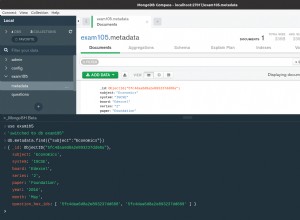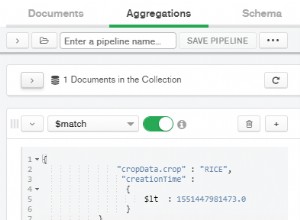Bạn có thể thử $facet với $addFields để tổng hợp song song trong 3.4 phiên bản.
Điều này sẽ làm giảm độ phức tạp tổng thể và bạn có thể chạy các nhóm với đầu vào phù hợp của riêng nó cùng một lúc.
Đoạn mã dưới đây xây dựng đường ống tổng hợp động dựa trên đối tượng yêu cầu.
// Sample request
var request = {
"name":"RINGGO",
"year": 2017,
"month":3,
"week":12
};
// Build initial match document on name
var match1 = {
name: request["name"]
};
// Build project & facet document for date based aggregation
var addFields = {};
var facet = {};
// Add year followed by year facet
if (request["year"]) {
addFields["year"] = { "$year": "$date" },
facet["Yearly"] =
[
{
"$match":{ "year": request["year"] }
},
{
"$group": {
"_id": {
"name": "$name",
"year": "$year"
},
"spend": { "$push":"$amount" },
"total": { "$sum": "$amount" }
}
}
];
}
// Add month followed by month facet
if (request["month"]) {
addFields["month"] = { "$month": "$date" };
facet["Monthly"] =
[
{
"$match":{ "month": request["month"] }
},
{
"$group": {
"_id": {
"name": "$name",
"month": "$month"
},
"spend": { "$push":"$amount" },
"total": { "$sum": "$amount" }
}
}
];
}
// Add week followed by week facet
if (request["week"]) {
addFields["week"] = { "$week": "$date" };
facet["Weekly"] =
[
{
"$match":{ "week": request["week"] }
},
{
"$group": {
"_id": {
"name": "$name",
"week": "$week"
},
"spend": { "$push":"$amount" },
"total": { "$sum": "$amount" }
}
}
];
}
// Use aggregate builder
statements.aggregate()
.match(match1)
.append({"$addFields": addFields}) // No addFields stage in mongoose builder
.facet(facet)
.exec(function(err, data) {});
Truy vấn Mongo Shell cho name/year/month/week tiêu chí.
db.statements.aggregate({
'$match': {
name: 'RINGGO'
}
}, {
'$addFields': {
year: {
'$year': '$date'
},
month: {
'$month': '$date'
},
week: {
'$week': '$date'
}
}
}, {
'$facet': {
Yearly: [{
'$match': {
year: 2017
}
},
{
'$group': {
_id: {
name: '$name',
year: '$year'
},
spend: {
'$push': '$amount'
},
total: {
'$sum': '$amount'
}
}
}
],
Monthly: [{
'$match': {
month: 3
}
},
{
'$group': {
_id: {
name: '$name',
month: '$month'
},
spend: {
'$push': '$amount'
},
total: {
'$sum': '$amount'
}
}
}
],
Weekly: [{
'$match': {
week: 12
}
},
{
'$group': {
_id: {
name: '$name',
week: '$week'
},
spend: {
'$push': '$amount'
},
total: {
'$sum': '$amount'
}
}
}
]
}
})
Phản hồi mẫu
{
"Yearly": [{
"_id": {
"name": "RINGGO",
"year": 2017
},
"spend": [-3.3, -6.3, -3.3, -6.3, -3.3, -3.3],
"total": -25.799999999999997
}],
"Monthly": [{
"_id": {
"name": "RINGGO",
"month": 3
},
"spend": [-3.3, -6.3, -3.3, -6.3, -3.3, -3.3],
"total": -25.799999999999997
}],
"Weekly": [{
"_id": {
"name": "RINGGO",
"week": 12
},
"spend": [-6.3, -3.3],
"total": -9.6
}]
}
Bạn có thể chạy tập hợp tương tự cho Year/Month và Year giá trị đầu vào.
Điều này xảy ra trong $group 1 nơi $week tổng hợp cuộn lại mỗi ngày trong số hai ngày [15, 16] số tiền vào tuần 11 và hai ngày khác [22, 23] vào tuần 12 sau đó để hiển thị dưới dạng tổng được tổng hợp trong MonthySpends .




